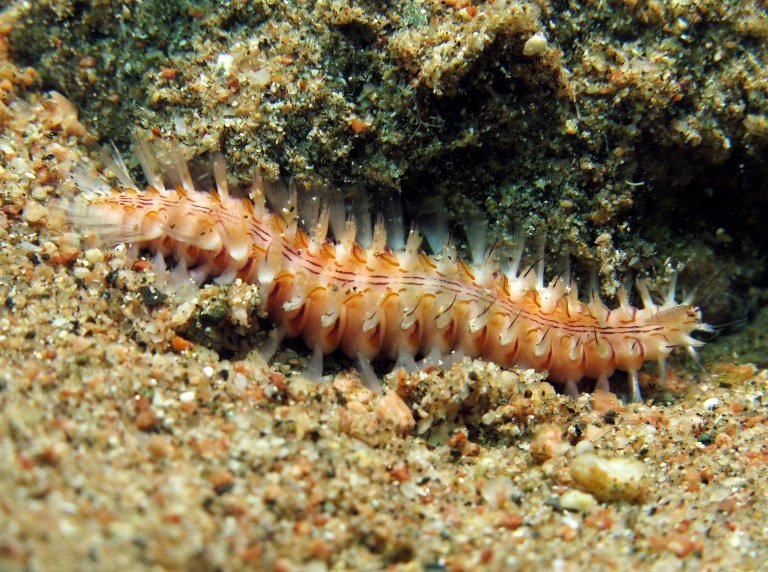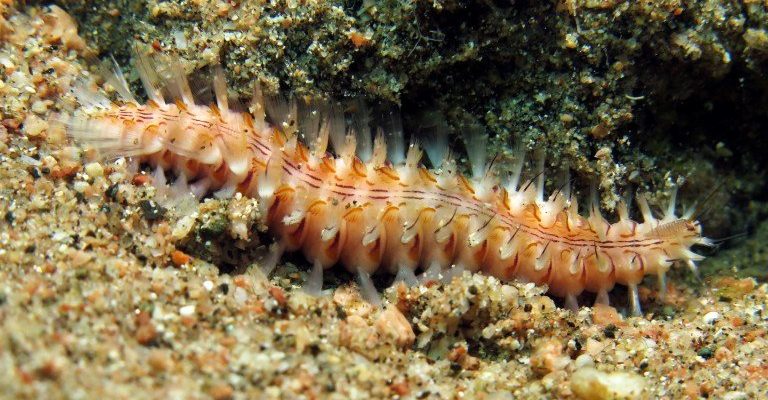
First off, bristle worms belong to a group of segmented worms called polychaetes, which are often found in both freshwater and marine environments. They play vital roles in the ecosystem, helping break down organic matter. Yet, many aquarists fear they may harm corals. In this article, we’ll explore the myths and facts surrounding these creatures and how they interact with corals. So grab your favorite drink, and let’s dive in!
What Are Bristle Worms?
Bristle worms are often seen as the little scavengers of the sea. They can range from a few millimeters to several feet in length and showcase a variety of colors, including brown, red, and green. These worms are characterized by thin, hair-like bristles that cover their bodies, giving them a spiky appearance. You might even stumble upon them in your aquarium substrate, where they’re busy breaking down waste and recycling nutrients.
Here’s the thing: while they might look a bit creepy, most bristle worms are harmless. They primarily feed on detritus, a fancy term for decomposing organic matter. Think of them as nature’s clean-up crew, helping to keep your tank clean and balanced. However, some species can grow quite large and become a nuisance if their populations explode, leading to other issues in your aquarium.
Bristle worms can also reproduce rapidly, especially in nutrient-rich environments. If you notice an uptick in their numbers, it might indicate that your water quality needs a closer look. Maintaining a balanced tank is essential to keep them in check and ensure they serve their purpose without becoming a problem.
Are Bristle Worms Harmful to Corals?
This is where things get a bit murky. Many aquarists believe that bristle worms can irritate corals, but the reality is more nuanced. Generally, bristle worms do not directly harm corals. They are mostly scavengers and are more interested in munching on decaying matter rather than actively preying on your corals. However, they can be associated with other issues that might lead to coral irritation.
For instance, if your tank is overrun with bristle worms, it could indicate excess waste or decaying food. This buildup can lead to poor water quality, which, in turn, stresses corals. Stress can manifest as irritation, color loss, or even tissue damage. So, the presence of bristle worms can indirectly affect coral health but usually isn’t the root cause of the problem.
If you’re keeping corals, it’s essential to focus on overall tank health. Regular maintenance, water testing, and providing a balanced environment will help keep both your corals and bristle worms happy. Remember, it’s all about finding that balance!
How to Manage Bristle Worm Populations
So now that we understand bristle worms better, how do we manage their populations in the aquarium? There are several methods you can use, depending on how many of these creatures you’re dealing with. Here are some strategies:
- Maintain Water Quality: Regular water changes and monitoring parameters like ammonia, nitrites, and nitrates can help keep bristle worm populations in check. Your goal should be to create an environment that discourages excessive growth.
- Limit Food Waste: Be mindful of how much food you’re adding to the tank. Uneaten food can encourage bristle worm reproduction. Feed sparingly and remove any leftovers.
- Manual Removal: If you find your tank overflowing with bristle worms, you may need to resort to manual removal. Use a pair of tweezers to pick them out during maintenance. Just be careful—those bristles can irritate your skin!
- Introduce Natural Predators: Some fish species, like certain wrasses, will eat bristle worms. However, research carefully to ensure the fish are compatible with your tank mates and won’t harm your corals.
These strategies can help manage bristle worm populations while maintaining a healthy aquarium environment. With the right approach, you can enjoy a thriving reef tank without the worry of your bristle worms being a problem.
Common Misconceptions About Bristle Worms
Let’s take a moment to clear the air on some common myths surrounding bristle worms. One of the biggest misconceptions is that all bristle worms are bad for tanks. As we’ve discussed earlier, most species are actually beneficial and work hard to recycle nutrients.
Another myth is that bristle worms actively harm healthy corals. While they can be associated with coral irritation, it’s important to note that irritation is often a symptom of underlying issues—like water quality or feeding practices—not a direct attack from the worms themselves.
Lastly, some people believe that removing bristle worms entirely from the aquarium is necessary to maintain coral health. In reality, a few bristle worms, when managed properly, can have a positive effect by keeping the substrate clean. It’s all about finding that balance!
Coral Irritation: What to Look For
If you’re concerned about coral irritation and how it might relate to bristle worms, it’s key to know what signs to look for. Coral irritation can manifest in various ways, and being proactive can help you address potential issues early.
Common signs of coral irritation include:
- Color Loss: Healthy corals often display vibrant colors. If you notice fading or dull hues, it could indicate stress.
- Recession: Tissue loss or recession of coral polyps may suggest irritation. This can happen if corals are not receiving adequate light or nutrients.
- Increased Polyp Behavior: If corals retract their polyps more than usual, it could signal discomfort or stress.
- Mucus Production: Excessive mucus is another sign of irritation. Some corals secrete mucus as a defense mechanism against irritants.
If you observe any of these signs, take a step back and evaluate your tank conditions. Test water parameters, check for excessive waste, and look at your feeding habits. Often, resolving these underlying issues can help your corals bounce back to health.
Final Thoughts: Finding Harmony in Your Aquarium
In conclusion, the relationship between bristle worms and coral irritation isn’t as cut-and-dry as it seems. While these worms are not inherently harmful, they can be indicators of larger issues in your tank. When managed correctly, they can coexist peacefully with your corals as part of a balanced ecosystem.
By focusing on water quality and proper feeding practices, you can keep both bristle worms and corals healthy. Remember, a thriving aquarium is about balance and understanding the roles of all its inhabitants—including those bristly little guys! As always, stay observant and proactive, and your aquarium will flourish. Happy aquascaping!

